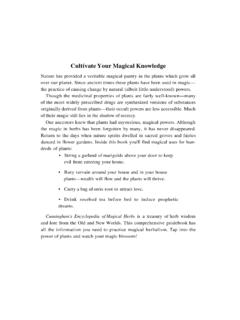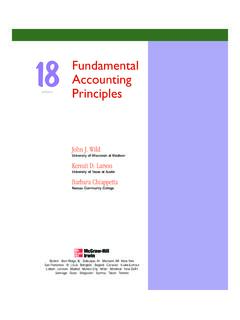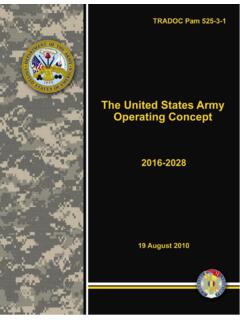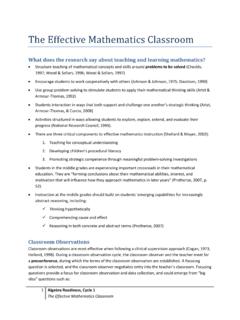Transcription of Leadership Styles and Their Consequences
1 I Leadership Styles and Their Consequences D. D. Warrick University of Colorado This article discusses Leadership style theories and offers an integration of the theories by describing the typical characteristics, philpsophy, skills, and Consequences associated with each major style. Then an ex- perimental exercise is offered that portrays the major Styles and the productivity and satisfaction each is likely to produce. Finally, a de- briefing is presented that helps interpret the exercise and integrate the style theories with contingency theory. Importance of Leadership Style Few leaders understand the full significance of how influential Their Leadership style is on the performance and satisfaction of Their employees. Leaders control both interpersonal and material rewards and punishments that often shape employee behavior and influence an employee s performance, motivation, and attitude. They can affect an employee s self-image and resulting potential in either a positive or negative way by being supportive, fair, and encouraging, or unsupportive, inconsistent, and critical.
2 In addition, they can even affect an employee s health and energy level by creating a stimulating work climate or one filled with tension and fear. The influence of a leader s style reaches greater proportions as the effects on individuals begin to have a cumulative effect on group performance. There are no doubt variables other than a leader s style that affect employee performance and satisfaction. Certainly, job challenge and in- terest, organizational working conditions and work climate, opportuni- ties for growth and advancement, and peer relations among other factors should be considered. However, the potential Consequences of a leader s style should be understood and not be underestimated. Address reprint requests to: Dr. Don Warrick, College of Business Administration, University of Colorado, Colorado Springs, CO 80908. Journal of Experiential Learning and Simulation 3-4: 155-172(1981) 0 Elsevier North Holland, Inc., 1981 52 Vanderbilt Ave.
3 , New York, New York 10017 155 0162-6574/81/3-40155-18$ 156 D. D. Warrick D. D. Warrick is an Associate Professor of Management and Organization Behav- ior at the University of Colorado, Colorado Springs campus. He is the editor of the Academy of Management OD Newsletter and serves on the OD Executive Committees of the Academy of Management and the American Society for Train- ing and Development. His articles have appeared in several leading management journals. He received his from the University of Southern California. Leadership Theories Most authorities on organizational Leadership agree that the major theories of Leadership are the traits, Leadership Styles , and contingency (sometimes called situational) theories. The Leadership Styles and contingency theories now dominate the current literature on Leadership while the traits theory has generally been dismissed because of the theoretical, methodological, and practical problems involved in trying to identify and support a consistent list of traits.
4 Major Leadership Styles Theories Ohio State Leadership Studies The Leadership Styles approach emerged from the Ohio State University Leadership studies that began in 1945. Some of the chief contributors to the study were Hemphill, Stogdill, Coons, Fleishman, Harris, and Burtt [l-31. While this study was responsible for a variety of significant find- ings on Leadership , perhaps the most important contribution was the isolation of Consideration and Initiating Structure as the basic di- mensions of Leadership behavior in formal organizations. These variables were identified as a result of a series of investigations that attempted to determine, through factor-analytic procedures, the smallest nuwber of dimensions that adequately describe leader behavior as perceived by the leader and his subordinates. Consideration may be defined as behaviors by means of which the leader establishes rapport with his or her employees, two-way commu- nication, mutual respect, and understanding.]
5 It includes behavior indi- cating trust and warmth between the supervisor and his or her group and emphasizes concern for group members needs. Initiating Structure may be defined as behaviors by means of which the leader defines or facilitates group interaction toward goal attainment. The leader does this by planning, scheduling, criticizing, initiating ideas, organizing the work, defining member roles, assigning tasks, and push- ing for production. It was during the early Ohio State studies that Leadership was first plotted on two separate axes as opposed to being on a single continuum. University of Michigan Leadership Studies The University of Michigan followed in 1947 with an extensive study of Leadership that resulted in many similar findings to the Ohio State stud- ies. Kahn, Likert, Katz, Maccoby, and Morse [4, 51 were some of the original investigators. They investigated the relationship between su- pervisory behavior and employee productivity and satisfaction.]
6 The ear- liest study was conducted at the Prudential Life Insurance Company and the strategy was to use company accounting procedures to identify high- I Leadership Styles and Their Consequences 157 producing and low-producing groups which were evidently equal in ability, background, etc. Then they would investigate the supervisory practices associated with the high and low producing groups. The Uni- versity of Michigan group identified two Styles of leaders-Employee- Centered and Praduction-Centered. Employee-Centered supervisors spent more time in actual, supervisory activities, less time performing tasks similar to those performed by sub- ordinates, used general rather than close supervision, took a personal interest in employees and Their gods, and were less punishing when mistakes were made. Employees of employee-centered supervisors felt that Their supervisor took a persopal interest in them, let them know how they were doing on the job, and would support them.
7 Production-Centered supervisors spent less time in actual supervisory practices such as planning, more time performing tasks similar to those subordinates performed, used close supervision, and punished mistakes. Employees of production-centered supervisors tended to feel as if they were treated only as instruments of production and responded with poor performance. In the earlier studies, employee-centered and production-centered su- pervisors were treated as if they represented opposite ends of a single continum. However, in later studies it was discovered that these two dimensions were independent and could occur simultaneously. Other Leadership Styles Theories The Ohio State and University of Michigan studies stimulated consid- erable interest in Leadership theory and many new theories were offered such as those by Keith Davis [6], Hersey and Blanchard [7], and Blake and Mouton [8]. Most of the Leadership theories had two things in com- mon. They identified two basic dimensions of Leadership and they re- sulted in four basic Leadership Styles (see Figure 1) which in effect de- scribed an Autocratic Leader (High emphasis on performance and low emphasis on people), Laissez Faire Leader (low emphasis on perform- ance and people), Human Relations Leader [low emphasis pn perform- ance and high emphasis on people), and Democratic Leader (high em- phasis on performance and people).]
8 The Managerial Grid A somewhat transitional theory between the Leadership Styles theories and the contingency theories is the Managerial Grid developed by Blake and Mouton [9]. Blake and Mouton described the two basic dimensisns of Leadership as Concern for production and concern for people. The term concern for, as used in the grid, is a theoretical variable reflecting basic attitudes or Styles of control. It does not reflect actual production or effectiveness. The horizontal axis of the management grid represents concern for production and the vertical axis represents concern for ma- ture and healthy relations among those engaged in production. Each axis is on a 1 to 9 point scale, with 1 representing a minimum interest or concern and 9 a maximum concern. The Managerial Grid results in five basic Styles of Leadership : A Production Pusher (9,1), Do-Nothing Man- ager (l,~), Organization Man [5,5), Country Club Manager (1,9), and Team Builder (9,9).]
9 158 D. D. Warrick I Blake and Mouton s Leadership Styles theory is considered transitional for several important reasons. First, Their two Leadership dimensions are interdependent rather then independent. Next, Their dimensions de- scribe basic attitudes rather than specific behaviors. This important dif- ference makes it possible for a leader to exhibit a variety of behaviors while using the same style. Thus, a 9,9 manager may in fact use consid- erable flexibility in applying his or her style. Finally, Blake and Mouton point out that one of the reasons Leadership Styles research has been so inconsistent is because of the inconsistency in conceptualizing the dif- ferent Styles . They claim that when the Managerial Grid model is used, behavioral science research consistently supports the 9,9 style as the one best style [lo]. Integrating the Leadership Sty1es Approach Leadership Style Characteristics, Philosophies, and Skills Leadership Styles can be identified by Their style characteristics, an im- plicit Leadership philosophy, and a set of management skills typical of each style.
10 Leadership Style Characteristics describe the emphasis a leader places on performance and people. Leadership Philosophy describes an implicit Leadership philosophy based primarily on a leader s assumptions about people and the role of a leader. A leader needs to be aware of these Figure 1 Four Basic Leadership Styles Human Relations Leoder Low emphasis on performance and a high emphasis on people. Assumes that all people are honest, trustworthy, self-moti- vated and want to be involved and that a participative, permissive, and supportive work environment will lead to happy workers that are productive workers, Re- lies on teamwork, human relations, participative decision-making, and good harmony and fellowship to get the job done! Democratic Leader High emphasis on performance and peo- ple. Assumes that most people are hon- est, trustworthy, and will work hard to ac- complish meaningful goals and challenging work. Strives for a well orga- nized and challenging work environment with clear objectives and responsibilities and gets the job done by motivating and managing individuals and groups to use Their full potential in reaching organiza- tional as well as Their own personal objec- tives.

















